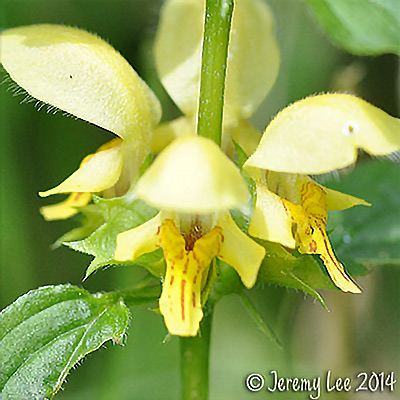
 |
|
Scientific Classifications explained » Amphibians » Ants » Aphids » Bees » Beetles » Birds » Bugs » Butterflies » Caterpillars » Damselflies » Dragonflies » Earwigs » Flies » Frog/Leafhoppers » Fungi » Galls » Grasshoppers » Harvestmen » Hoverflies » Lacewings » Ladybirds » Leaf Mines » Lichens » Mammals » Millipedes » Mosses » Moths » Sawflies » Slugs » Snails » Spiders » Trees & Shrubs » Wasps » Wild Flowers » Woodlice » Postboxes |
UK Nature > Wild Flowers > Yellow Wild Flowers > Lamium galeobdolon

Scientific Name: Lamium galeobdolon Common Name: Yellow Archangel, Yellow Dead-nettle The flowers of Lamium galeobdolon, more commonly known as Yellow Archangel or Yellow Dead Nettle, come into bloom just as the Bluebells are fading, replacing the blue carpet of a spring woodland with a golden-yellow one. In common with Lamium album, the White Dead-nettle, this creeping perennial of the Mint (or Dead-nettle) family is much more nettle-like in appearance than is its close relative Lamium purpureum, Red Dead-nettle. Indeed, this spring wildflower is sometimes referred to as Yellow Dead-nettle. This plant prefers damp places and partial shade. Being a perennial, Yellow Archangel takes a time to become established, but once it get going, it crowds out most other plants. Some colonies are thought to have survived in some places for hundreds of years in undisturbed sites. In Britain and Ireland the main flowering period of this wildflower is May and June, but following a mild winter you may find Yellow Archangel in bloom as early as April. |
|

https://www.uknature.co.uk is a website dedicated to showing the immense diversity of UK nature and wildlife. Our vast range of habitats, from lowland arable to snow covered mountains, from storm-ravaged coastlines to peaceful inland freshwater lakes and rivers, from dry, sandy heaths to deciduous and coniferous forests, all these habitats contribute to the abundance of UK nature. We have wild birds in huge numbers either residing or visiting our shores (597 recorded species as at July 2013) and we must also not forget the humble back garden with its grass lawns, flower beds filled with nectar rich flowers, shrubs and trees, all designed to attract huge numbers of insects such as bees, moths, butterflies and hoverflies; and finally the small ponds which provide safe havens for frogs, toads, newts and even slow worms and grass snakes. www.uknature.co.uk is the showcase for my personal passion, photographing uknature in all its glory. I sincerely hope you all enjoy the fruits of my labours. This site and all images contained therein is © Jeremy Lee 2004 - 2025. All Rights Reserved. Site design by Jeremy Lee. Site development & IT Support by Stuart Lee. |